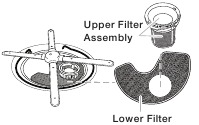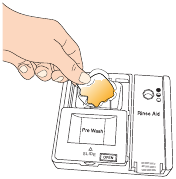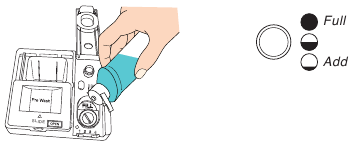KitchenAid KDTE104ESS Dishwasher User Guide


Your safety and the safety of others are very important.
We have provided many important safety messages in this manual and on your appliance. Always read and obey all safety messages.
This is the safety alert symbol.
This symbol alerts you to potential hazards that can kill or hurt you and others.
All safety messages will follow the safety alert symbol and either the word "DANGER" or "WARNING."
These words mean:
You can be killed or seriously injured if you don't immediately follow instructions.
You can be killed or seriously injured if you don't follow instructions.
All safety messages will tell you what the potential hazard is, tell you how to reduce the chance of injury, and tell you what can happen if the instructions are not followed.
When using the dishwasher, follow basic precautions, including the following:
- Read all instructions before using the dishwasher.
- Use the dishwasher only for its intended function.
- Use only detergents or rinse agents recommended for use in a dishwasher, and keep them out of the reach of children.
- When loading items to be washed:
- Locate sharp items so that they are not likely to damage the door seal; and
- Load sharp knives with the handles up to reduce the risk of cut-type injuries.
- Do not wash plastic items unless they are marked "dishwasher safe" or the equivalent. For plastic items not so marked, check the manufacturer's recommendations.
- Do not touch the heating element during or immediately after use.
- Do not operate the dishwasher unless all enclosure panels are properly in place.
- Do not tamper with controls.
- Do not abuse, sit on, or stand on the door, lid, or dish racks of the dishwasher.
- To reduce the risk of injury, do not allow children to play in or on the dishwasher.
- Under certain conditions, hydrogen gas may be produced in a hot water system that has not been used for two weeks or more. HYDROGEN GAS IS EXPLOSIVE. If the hot water system has not been used for such a period, before using the dishwasher turn on all hot water faucets and let the water flow from each for several minutes. This will release any accumulated hydrogen gas. As the gas is flammable, do not smoke or use an open flame during this time.
- Remove the door or lid to the washing compartment when removing an old dishwasher from service or discarding it.
SAVE THESE INSTRUCTIONS
State of California Proposition 65 Warnings:
This product contains one or more chemicals known to the State of California to cause cancer.
This product contains one or more chemicals known to the State of California to cause birth defects or other reproductive harm.

Tip Over Hazard
Do not use dishwasher until completely installed.
Do not push down on open door.
Doing so can result in serious injury or cuts.
GROUNDING INSTRUCTIONS
- For a grounded, cord-connected dishwasher:
The dishwasher must be grounded. In the event of a malfunction or breakdown, grounding will reduce the risk of electric shock by providing a path of least resistance for electric current. The dishwasher is equipped with a cord having an equipment-grounding conductor and a grounding plug. The plug must be plugged into an appropriate outlet that is installed and grounded in accordance with all local codes and ordinances.
SAVE THESE INSTRUCTIONS
KEY USAGE TIPS
Filtration System and Maintenance
The filter system consists of two parts: an upper filter assembly and a lower filter.

To avoid damage to dishwasher, do not operate your dishwasher without filters properly installed. Be sure lower filter is securely in place and upper filter assembly is locked into place. If upper assembly turns freely, it is not locked into place.
The filters may need to be cleaned when:
- Visible objects or soils are on upper filter assembly.
- Dishes feel gritty to the touch.

Do not use wire brush, scouring pad, etc., as they may damage the filters.
Rinse filter under running water until soils are removed. If you have hard to remove soils or calcium deposits from hard water, a soft brush may be required.
Easy to remove third level rack (on some models)

If additional space is needed in the upper rack, the third level rack can easily be removed
To remove, fully extend rack until it stops. Then open the track stops on each side and lift to remove.
Drying - Rinse Aid is essential

You must use a drying agent, such as a rinse aid, for good drying performance. Rinse aid along with the Heat Dry option provides the best drying and avoids excessive moisture in the dishwasher interior.
Energy efficiency

Energy efficiency is gained by extending cycle time and reducing the amount of wattage and water used during your dishwasher's cycle. All models contain an optical water sensor to determine water and energy consumption. Your first cycle will run longer to calibrate the optical water sensor.
Efficient dishwashers run longer to save water and energy, just as driving a car slower saves on gas.
Press start/resume every time you add a dish

If anyone opens the door (such as, for adding a dish, even during the Delay Hours option), START/RESUME must be pressed each time.
Push door firmly closed within 3 seconds of pressing START/RESUME. If door is not closed within 3 seconds, the start button LED will flash, an audible tone will be heard, and cycle will not start.
OPERATING YOUR DISHWASHER

- Prepare and Load the Dishwasher
Remove leftover food, bones, toothpicks and other hard items from dishes. Remove labels from containers before washing.
- Make sure that, when the dishwasher door is closed, no items are blocking detergent dispenser.
- Items should be loaded with soiled surfaces facing down and inward to the spray as shown in the graphics above. This will improve cleaning and drying results. Angle dirtiest dish surface downward, allowing space for water to flow up through rack and between dishes.
- Avoid overlapping items like bowls or plates that may trap food.
- Place plastics, small plates and glasses in upper rack.
- Wash only items marked "dishwasher safe."
- To avoid thumping/clattering noises during operation: Load dishes so they do not touch one another. Make sure lightweight load items are secured in racks.
- When loading silverware, always place sharp items pointing down and avoid "nesting" as shown. If your silverware does not fit into the designated slots, lift and slide covers off to remove them and mix silverware types to keep them separated.
- Use slots in the covers and suggested loading patterns to keep your silverware separated for optimum wash.
- Check that Spray Arms are not Blocked
Items in the rack can block the spray arms. Be sure that they do not block the upper or lower spray arms.

- Add Detergent
NOTE: If you do not plan to run a wash cycle soon, run a rinse cycle.
Do not use detergent.
- Use automatic dishwasher detergent only. Add detergent just before starting a cycle.
- Fresh automatic dishwasher detergent results in better cleaning. Store tightly closed detergent container in a cool, dry place.

Detergents
Many detergents now come in several forms (gel packs, tablets, or powder packs).
We recommend tablets and packs for convenience and improved performance. Quality tablets and packs have been proven better than powder, liquid or gel detergents at reducing filming on dishes. Using tablets and packs over time will start to reduce or eliminate white film. Also, by using a rinse aid, you can minimize repeat buildup of white film. These forms are suitable for all hardness and soil levels. Always place detergents in the main compartment and slide lid to close.
NOTE: Follow instructions on the package when using other dishwasher detergent types.

To close lid
Place selected detergent in the dispenser. Place finger, as shown, and slide lid closed. Press firmly until it clicks.

To open lid
Push OPEN, as shown, and the lid will slide open.
- Add Rinse Aid
- Your dishwasher is designed to use rinse aid for good drying performance. Without rinse aid, your dishes and dishwasher interior will have excessive moisture. The heating and drying options will not perform as well without rinse aid.
- Rinse aid keeps water from forming droplets that can dry as spots or streaks. It also improves drying by allowing water to drain off of dishes after final rinse.
- To add rinse aid, open the dispenser lid by gently pushing in the center of the lid with your thumb while lifting up on the edge.

- Pour rinse aid into the opening until the indicator level shows that it is full.

- Close dispenser by pushing down gently on the lid.
NOTE: For most water conditions, the factory setting will give good results.

If you are experiencing poor drying performance, you may want to try a higher setting. Turn the arrow adjuster to a higher setting to increase the amount of rinse aid.
- Select a Cycle
Efficient dishwashers run longer to save water and energy, just as driving a car slower saves on gas. Typical cycle time is approximately 2¹⁄₂ hours but can take less or more time to complete depending on selections.
- Select Options
You can customize your cycles by pressing the options desired. If you change your mind, press the option again to turn off the option. Not all options are available for every cycle. If an invalid option is selected for a given cycle, the lights will flash.
- Start or Resume a Cycle
NOTE: Run hot water at sink nearest your dishwasher until water is hot.
Turn off water.
- If Start/Resume button is located on top of door, push door firmly closed within 3 seconds of pressing START/RESUME. If door is not closed within 3 seconds, the Start button LED will flash, an audible tone will be heard, and cycle will not start.
If anyone opens the door (such as, for adding a dish, even during the Delay Hours option), the Start/Resume button must be pressed each time.
- If the Start/Resume button is located on front of door, push door firmly closed. The door latches automatically. Select wash cycle and options and then press START/RESUME or press START/RESUME to repeat the same cycle and options as in previous wash cycle.
CYCLE GUIDE
This information covers several different models. Your dishwasher may not have all of the cycles and options described.
ProWash


















